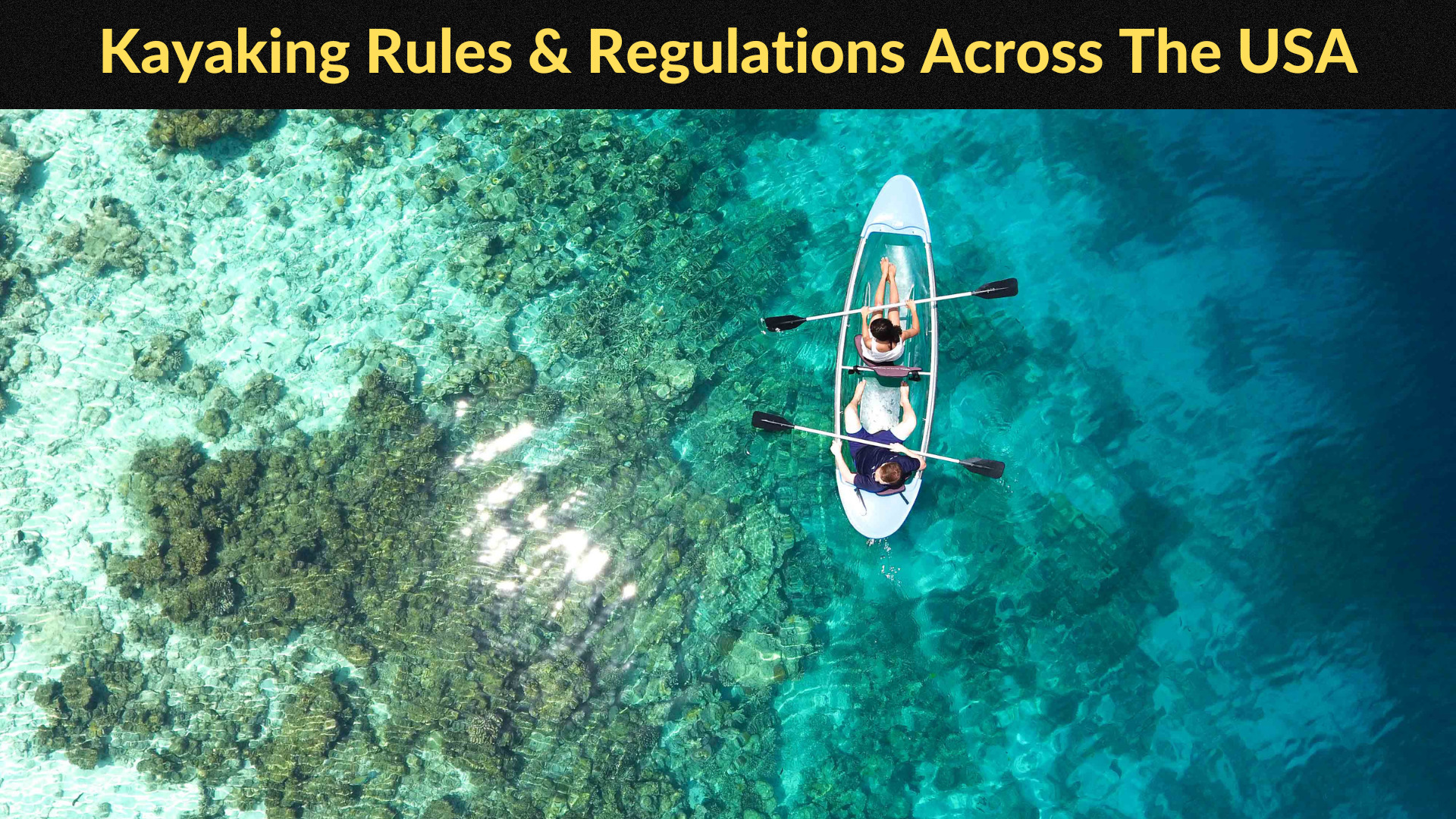Must Follow Kayaking Rules And Regulations In 2023
it’s important to remember that kayaking has risks, and it’s critical to follow the kayaking rules & regulations across the USA to stay safe and avoid legal trouble.
We’ll go through the kayaking rules and regulations in the United States. We’ll go over everything from safety equipment to waterway regulations so you can enjoy this exciting and engaging pastime safely and legally.
Kayaking Rules And Regulations Across The USA
In order to secure your safety and legal compliance when kayaking in the United States, you should be aware of the following Kayaking Rules & Regulations Across The USA. While exact laws may differ from one jurisdiction to another, the following are some broad principles and norms that are applicable in numerous areas:
Rules for kayaking on rivers
The sun is shining, the birds are chirping, and the river is calling out your name. You are ready to take your kayak out and experience the thrill of gliding through the waves. But before you set off, it is important to be aware of the rules and regulations for kayaking on rivers.
The most important rule of river kayaking is to always wear a life vest and helmet. This is to ensure your safety and protection from any potential hazards, such as rapids and treacherous obstacles.
It is also important to respect your fellow river kayakers by following the right-of-way rules, being aware of your surroundings, and always keeping your distance from other kayakers. Knowing the rules of the river will help you have an enjoyable experience kayaking on the river.
Kayaking Rules and Regulations Philippines
The rules and regulations of kayaking in the Philippines are strict, beginning with the requirement of a permit. Visitors must be at least 18 years of age to be eligible for one, and all must be affixed to the vessel. Safety equipment is also a must, as life jackets and whistles are mandatory. Failure to comply with these regulations could result in stiff penalties.
Kayaking Permits
The Philippines is a tropical paradise, with many waterways ideal for kayaking. Before setting out on the water, it is important to know the rules and regulations for kayaking in the country. One important rule is the need for a permit.
Kayaking permits must be obtained before setting out on the water, and are available from the local government or city hall. The permit is valid for one year and must be renewed annually. When obtaining a permit, several documents are required, including a valid ID, a copy of the kayaker’s birth certificate, and a copy of their marriage certificate if applicable. All documents must be authenticated and copies made.
The permit itself also requires some information, such as an up-to-date description of the kayak, including its dimensions, length, make, and model. It is also important to have a valid insurance policy for the kayak, as this is a requirement for obtaining the permit. The permit also includes a copy of the local kayaking regulations, which must be adhered to at all times while kayaking in the Philippines.
The process of obtaining a permit may seem daunting, but it is an important step in ensuring a safe and enjoyable experience kayaking in the Philippines.
Age Restrictions
The sun glistens off the crystal clear water as kayakers of all ages explore the Philippines. The country has a number of regulations that must be followed to ensure the safety of all those who venture out on its waters. One of these is age restrictions, which vary according to the type of kayaking activity.
For recreational kayak activities, such as touring and fishing, no age restrictions are in place. However, for more advanced activities such as white water kayaking, those aged fourteen and below must be accompanied by an adult. In addition, those aged sixteen and below must have parental or guardian permission in order to participate.
The Philippine Coast Guard also requires that those who kayak offshore must be aged sixteen and above, and those aged eighteen and below must have a parent or guardian on board. These age restrictions act as a safeguard to protect young kayakers and ensure that they enjoy their experience to the fullest.
Safety Equipment In the Philippines
In the Philippines, all kayakers are required to wear a life jacket at all times. The life jacket should be of the proper size and securely fastened. The life jacket must be bright enough to be seen in the water, especially during low light or night kayaking conditions.
Additionally, it is recommended to bring a whistle or other signaling device to alert rescuers in case of an emergency. By following these safety guidelines, kayakers can ensure that their journey is safe and enjoyable.
kayak safety requirements
To ensure safe kayaking, it is imperative to always wear a life jacket, be aware of the weather conditions, and be mindful of river hazards. Rushing water, debris, and even rocks can pose a threat to kayakers so always exercise caution and be aware of your surroundings. Lastly, never underestimate the power of the weather – always check the forecast before hitting the water.
Life Jackets
When it comes to kayaking, it is essential to ensure that safety is a top priority. The most important safety requirement when kayaking is the use of a life jacket. A life jacket is a type of personal flotation device that is designed to keep the wearer afloat in the water in the event of an emergency.
Life jackets come in a variety of styles and sizes, so it is important to choose the right one for the situation. They should fit snugly, but comfortably, and always be securely fastened. It is essential to check the fit and condition of the life jacket before each trip. This will allow for a safe and enjoyable kayaking experience.
Weather Conditions
It is essential for kayakers to be mindful of the weather conditions when planning a kayaking trip. Weather can be a major factor in the safety of the trip, and it should be taken into account before launching.
Before heading out, it is important to check the weather forecast and be aware of any potential storms or strong winds. The wind can make the trip more difficult and dangerous, especially if the kayaker is alone.
River Hazards
River debris is also a common hazard. From logs and branches to rocks, it is important to keep an eye out for anything that could be in the river. If the water is shallow enough, it is recommended to use a paddle to move the debris out of the way. If the water is too deep, it is best to stay away from the debris and look for a different route.
kayak night fishing regulations
The tranquility of a night spent fishing in a kayak on a river equipped with the necessary tools creates a peaceful experience for all. Anglers must adhere to age restrictions, ensuring that only those of the appropriate age can safely enjoy the activity. River access is readily available, with numerous spots to cast a line and soak in the beauty of the night.
River Access
Transitioning from safety requirements to night fishing regulations, one of the most important aspects to consider is river access. Rivers can be dangerous, and it is important to be aware of both your physical and legal capabilities. For the purpose of kayak night fishing, it is important to know the river access laws in the area.
Many states have laws that restrict the use of rivers or areas of rivers, so it is important to check in with the local authorities to be aware of these laws.
Additionally, it is important to be aware of the capability of the waterway. A river may seem calm and peaceful during the day, but at night the water can become much more turbulent.
kayak navigation lights rules
The kayak navigation lights rules dictate that kayaks must display the appropriate navigation lights in order to be visible and identifiable by other vessels. The lights must adhere to specific requirements in terms of color and pattern, and the identification of the vessel must be easily recognizable. Furthermore, the location, angle, and height of the lights must meet the prescribed standards.
Navigation Lights Requirements
kayakers should also be aware of the navigation light requirements. These lights provide a crucial safety measure for kayakers embarking on a nighttime adventure. For most kayakers, the navigation lights are essential for being seen and adhering to the rules of the water.
Navigation light requirements vary, depending on the location. In the United States, kayakers are required to have a light visible for two miles. This light must be visible from all directions and should be placed in a location that is easy to access. The light must also be visible from the kayaker’s paddle.
Color Requirements
Illuminating the night sky, navigation lights are essential for kayak night fishing. From color requirements to light identification, navigation lights are an important part of following the rules and regulations. When it comes to the colors of navigation lights, there are specific requirements that must be followed.
requirements for kayaking
The size of the kayak should be selected with safety and comfort in mind. A buoyancy aid should be worn at all times to provide extra security while on the water, and the appropriate safety equipment should be carried in case of any emergency. A well-equipped kayaker is essential for a safe and enjoyable kayaking experience.
Kayak size
Moving away from the navigation light rules and regulations, let us now look into the requirements for kayaking. One of the main considerations when selecting a kayak is its size.
Depending on the type of kayaking, different sizes work better. For example, a longer, narrower kayak will track better and move faster, while a shorter, wider kayak will be more stable and maneuverable.
FAQ’s
What are the kayaking safety regulations in Florida?
It is critical to follow the state’s safety guidelines when kayaking in Florida to ensure a safe and pleasurable day on the water. All kayakers in Florida are required by law to wear a properly fitted personal flotation device (PFD) at all times while on the water. In addition, all kayaks must have a sound-producing device, such as a whistle, to inform other boaters in the event of an emergency. It’s also a good idea to wear clothing and footwear that protects you from the sun, wind, and water.
What equipment is required for a kayak in California?
Every person on board a kayak in California is required to wear a life jacket, also known as a personal flotation device (PFD). The PFD must be approved by the US Coast Guard and be the correct size for each individual.
Do You Need a Permit to Kayak in Florida?
Kayaking on public waters in Florida does not require a permit. Some water activities, like kayaking, may require a permit in some state parks and wildlife management areas. It is critical to know the specific rules and regulations for the location you intend to kayak in to ensure you meet all criteria.
What is a Kayak in the USA?
A kayak is a narrow, compact boat powered by a double-bladed paddle. It is intended for one or two passengers to sit in a low, enclosed cockpit with their legs stretched out in front of them.
Conclusion
You may have a safe and fun day on the water if you are aware of the kayaking rules and regulations in the United States. Always emphasize safety and adhere to the criteria established by your state and local governments.
You can have a memorable and exciting kayaking experience while remaining legal and protected if you have the proper equipment, education, and respect for the rules.

